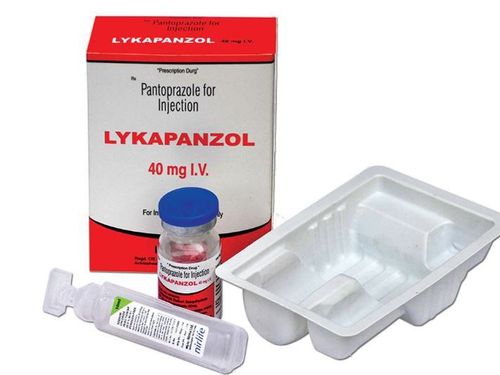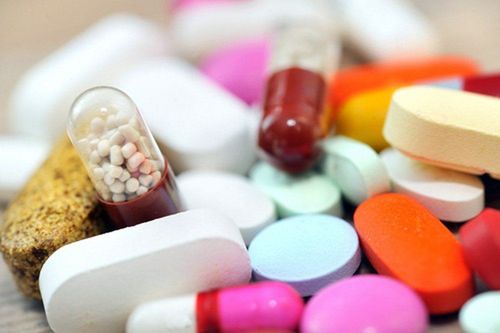This is an automatically translated article.
Glopantac 20 is a gastrointestinal medicine that is often prescribed by doctors for cases of peptic ulcer, gastroesophageal reflux disease. To learn about the ingredients and uses of Glopantac 20, please read the following article.
1. What is Glopantac 20?
Pharmaceutical name: Glopantac 20. Ingredients: Active ingredient Pantoprazol (as Pantoprazol sodium) 20 mg. Group of drugs: Glopantac 20 belongs to the group of drugs for the gastrointestinal tract. Dosage form: In the form of enteric coated tablets. Packing: Packed in a box of 3 blisters, each blister contains 10 tablets. Registration number: VD-22134-15. Manufacturing company: GLOMED Pharmaceutical Joint Stock Company. Registrant Company: GLOMED Pharmaceutical Joint Stock Company.
2. What are the effects of Glopantac 20?
Prescription drug Glopantac 20 has the ability to specifically and irreversibly inhibit the proton pump by selectively acting on the gastric cell wall, so it has a much faster and more effective effect than other drugs. other drugs. The healing rate (healing of ulcers) can be up to 95% after only about 8 weeks of treatment. On the other hand, the drug also has very little effect on volume of service, intragastric factors, pepsin secretion or gastric contractility.
Therefore, Glopantac is indicated for use in cases of gastroesophageal reflux disease (GERD), peptic ulcers. The drug is used in combination with 2 appropriate antibiotics to kill Helicobacter pylori in patients with peptic ulcers, to heal wounds and prevent recurrence.
3. Dosage and how to use Glopantac 20
3.1. Dosage of Glopantac 20 Tablets:
Recommended dose: For patients infected with Helicobacter pylori (positive), stomach and duodenal ulcers, it is necessary to kill bacteria by combination therapy. Depending on the type of resistance, the following combination schemes can be applied to eradicate Helicobacter pylori.
Regimen 1: Use twice a day (1 tablet of Pantoprazole + 500mg of Clarithromycin + 1000mg of Amoxicylline), used for 7 days. Regimen 2: Use twice a day (1 tablet of Pantoprazole + 500mg of Clarithromycin + 500mg of Metronidazol) for 7 days. Regimen 3: Use 3 times a day (1 tablet of Pantoprazole + 500mg of Metronidazol + 1000mg of Amoxicilline) for 7 days. Patients with gastroesophageal reflux disease (GERD): Use 1 tablet of 40mg/day.
Patients with severe liver failure: Need to reduce to 1 tablet (40mg Pantoprazole), taken every 2 days. On the other hand, close monitoring of liver enzymes is required during pantoprazole therapy. In case of elevated liver enzyme values, it is necessary to stop taking Pantoprazole.
Do not use with a dose of more than 40mg Pantoprazole for patients with renal failure or the elderly. With the exception of combination therapy for Helicobacter pylori eradication, the elderly also receive the usual dose of Pantoprazole (2 x 40 mg/day) for a period of 1 week of treatment.
Intravenous form:
It is recommended that patients use Pantoprazole I.V. when oral medication is not appropriate. The average intravenous dose of pantoprazole is 1 vial (40 mg pantoprazole) per day. The maximum dosage can be up to 6 vials/day divided into several doses.
For intravenous injection, inject 10ml of physiological saline solution (NaCl 0.9%) into the powder vial containing Pantoprazole 40mg lyophilizer, then administer slowly intravenously for at least 2 minutes.
For intravenous infusion, it is necessary to dilute Pantoprazole with 100ml of physiological saline or 100ml of Glucose 10% / 100ml of Glucose 5%, conduct intravenous infusion at least 15 minutes.
Note, do not mix or mix Pantoprazole I.V. with any solvent other than those listed above. The pH value of the solution must reach 9 and the reconstituted solution (prepared) must be used within 12 hours of preparation.
Dosage for children:
The differences in pharmacodynamics, pharmacokinetics, side effects... in children are much different from those in adults. In particular, young children are not allowed to conduct clinical trials before the drug is licensed for circulation. Therefore, when using drugs for children, it is necessary to be especially careful, even with drugs that have not been warned.
3.2. How to use Glopantac 20 Patients need to carefully read the instructions on how to use the drug listed on the instruction sheet, do not arbitrarily use other routes not mentioned in the drug instruction sheet.
Do not crush or chew the tablet, instead take it whole with a full glass of water, 1 hour before breakfast. In the case of combination therapy for the eradication of Helicobacter pylori, the second tablet should be taken before dinner. For combination therapy, only 7 days of treatment is enough to kill Helicobacter pylori and heal ulcers.
3.3. Dealing with missed dose or overdose of Glopantac 20 Overdose:
In case of overdose or emergency, appear dangerous, the patient should immediately contact a doctor or Emergency Center 115. At the same time You should tell your doctor about any prescriptions you are taking, including over-the-counter or prescription drugs. Missed dose:
If the patient forgets a dose during the course of taking the drug, it should be taken as soon as possible (usually about 1-2 hours from the requested time). However, if it is almost time for the next dose, skip the missed dose and take the next dose at the scheduled time.
4. Notes when using Glopantac 20
4.1. Contraindications Glopantac 20 Do not use Glopantac 20 for patients with a history of hypersensitivity to Pantoprazole, other excipients contained in the drug or other Benzimidazole derivatives (such as Lansoprazol, Esomeprazol, Rabeprazol, Omeprazol).
Contraindications of Glopantac are understood as absolute contraindications, which means that for no other reason, patients can flexibly use the drug.
4.2. Glopantac side effects 20 During treatment with Pantoprazole, sometimes patients will experience headache or mild diarrhea. In addition, you may experience more rare manifestations such as: upper abdominal pain, bloating, nausea, dizziness, skin rash, itching. A few rare cases such as: Fever, edema, thrombophlebitis.
Note, the above symptoms are not all side effects of the drug that the patient may experience. In the process of taking the drug, there may be many other side effects that have not been shown or have not been studied. Therefore, if you have any other symptoms while taking this medicine, you should consult your doctor or pharmacist.
4.3. Drug Interactions Pantoprazole has the potential to reduce the absorption of other drugs when administered in combination, whose absorption is pH dependent (eg, Ketoconazole). This situation also occurs with drugs used before Pantoprazole I.V for a short time. The active substance of Pantoprazole is metabolized in the liver by the cytochrome P450 enzyme system. The possibility that Pantoprazole may interact with other drugs metabolized in the same cytochrome P450 enzyme system is not excluded. However, in clinical studies, there have been no significant interactions in specific trials for some of the above compounds or drugs such as: Caffeine, Carbamazepine, Digoxine, Ethanol, Glibenclamide, Metoprolol, Diazepam, Diclofenac, Nifedipine, Warfarine, Phenprocoumon, Phenytoin, Theophylline and oral contraceptives. There is no interaction between Pantoprazole and antacids (for stomach pain) when used concurrently. No interactions with antibiotics used in combination (Amoxicylline, Clarithromycin and Metronidazol) during the eradication of Helicobacter pylori were observed. 4.4. Caution when using Glopantac 20 Patients are recommended to take the drug by injection in case oral administration is not appropriate. Before taking the drug, the patient must be excluded the possibility of malignant gastric ulcer or malignant esophagitis, because this condition may temporarily overwhelm the symptoms of malignant ulcer disease, leading to a delay in the progression of the disease. diagnose. To date, there is no experience in the treatment of pantoprazole in young children. The effect of Pantoprazole on people who must drive or operate machinery is not known. When using drugs for pregnant women can cause bad effects such as (teratogenic, miscarriage, fetal defects...) in any stage of pregnancy development, especially at 3 first month. Therefore, it is best not to use the drug for pregnant women, in case it is necessary to use it, it is necessary to consult a doctor to carefully weigh the harms and benefits. The drug can be passed on to infants through breast milk. It is best not to be used or minimized for women who are breastfeeding, so consult a doctor before use. We have just learned together about the uses of Glopantac and the most important information. However, the article is for reference only, to ensure the best effect and safety when used, patients should use the drug according to the instructions and instructions of the doctor or medical staff.













